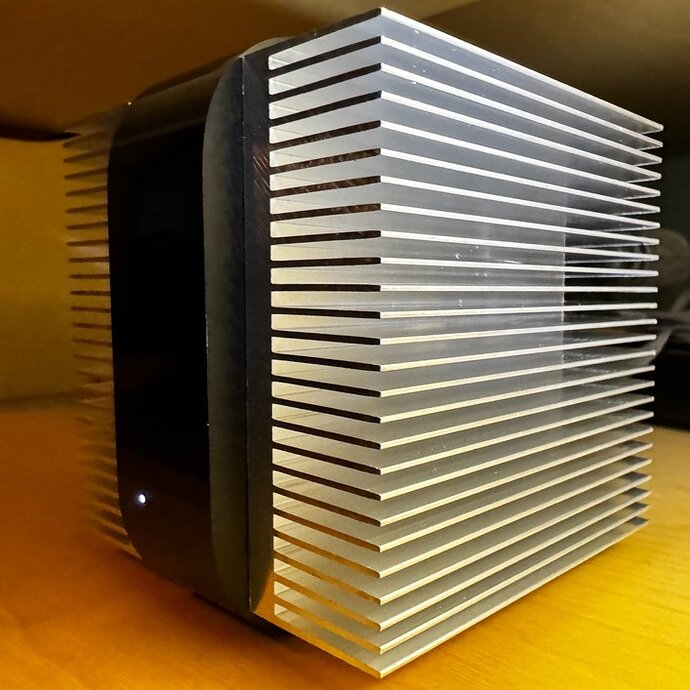Plex Stutters when playing 4K HDR files via Direct Play on AppleTV. On all three revisions of the AppleTV 4K. Even with gigabit ethernet connection. It’s intermittent, hard for Plex to reproduce. Often the first 20min or so of a file will work fine, but then it starts to drop frames.
![]() The cause is thermal throttling from excessive CPU load.
The cause is thermal throttling from excessive CPU load. ![]()
Which actually explains all the weirdness we’re seeing.
We’ve been facing this issue for years. I’ve read so many threads, here and on reddit. Some people post settings changes that work for them, which don’t work for others, or don’t work for long.
There’s 50 more of these threads on these board and elsewhere.
When some people use the old audio player, or the old video player, it’ll work. Some people (@atamido) turn on Auto Adjust Quality and/or enable Allow Direct Play.
For some this works, for others it doesn’t. ![]()
It’s because the old players, the old/reduced settings use slightly less CPU. Generate slightly less heat. Updated versions (8.13 vs 8.12) are doing a bit more, pushing the thermal envelope just enough.
And of course every one of our rooms is a different temp. Every one of our AppleTVs is sitting on a different surface enclosed/open, next to different heat-generating devices.
tvOS 17 is being reported as making it worse. iOS 17 just released an overheating fix for 17.0.2, maybe that will help if it comes to tvOS. It’s been a problem long before tvOS 17 though. But that would make sense if it used more CPU, made the underlying overheating issue worse.
–
@DaveBinM and @chrisallen, This is why you’re having such a hard time reproducing.
Very first thing you should do is measure CPU use, and ideally thermal state in the Debug screen so we can all see what’s happening when frames are dropping.
You can access thermal state in Swift via ProcessInfo.processInfo.thermalState. Here’s a singleton example that will subscribe live to changes.
I’ll bet a year’s Plex Pass that this will make reproducing and debugging these issues 10x easier for all of us.
The next thing you should do is build a process to identify when the player starts melting the cpu after making a change.
Probably a good idea is to have a mode during internal testing that throws up a red border or something any time the thermal state or cpu gets too high. If it’s up too long, you’ve got a problem. Not a bad idea to do a bit of thermal stress testing (put it in a wood box, maybe) to eliminate things like testing it in a cool office on a good conducting desk or whatever.
Anyway, your call on that. I can help with ideas, I do this sort of thing for a living.
–
Here’s my testing which found that it was thermal throttling…
Recently my 4K HDR videos have begun stuttering 20-30min into the movie. I’m only ever using Direct Play from the server via gigabit ethernet connection. Playback becomes unusable. (These are files that previously played fine.)
It started on a scene with tons of complexity and fast-motion, but even if I rewound 10min it would be happening on scenes that had just played fine moments before.
Debug overlay shows file streaming buffer never drops below 50 seconds. It ain’t a network issue. (Which so many before have confirmed.)
This of course is 100% consistent with thermal load issues. Maybe iOS 17 became more sensitive to thermal state, maybe there’s higher background CPU load, maybe recent changes with Plex have caused higher CPU load. Maybe the weather’s colder and my heat is on in the room instead of A/C. ![]()
Read on for more detail…
I turned debug on and tried all the ‘solutions’ in the threads above and elsewhere to see if I could get the Dropped Frames to zero. Nothing worked. Though some did help. The number of dropped frames would grow more slowly, especially on less complex scenes. But they’d continue to grow and grow.
Key thing I noticed: (This is important for reproducing the issue.) When I’d pause, read some solutions, or even go out to the menu and go back in (only 20 seconds or so), the stuttering and frame drops would go away for a while. Only when I played long enough, on complex enough scenes would the stuttering come back. And it would be back on the scenes before that I’d just played through.
Therefore, when testing, you MUST let these files play long enough. Complex enough. The AppleTV is fanless, but still pretty impressive at shedding heat. It has to hit the throttling heat threshold and then be pushed to stay there, otherwise it will quickly cool down.
So everything failed to eliminate frame drops, but after noticing this behaviour, I suspected it was SUSTAINED COMPLEXITY that was causing my issues to recur. That made me think of the heat. (For my particular room temp and low-heat-conducting wood surface it was sitting on.)
So I walked over and felt my AppleTV. It was BLISTERING HOT. ![]()
==Thermal Throttling Test==
Same video, same everything, except I turned all the settings back to their default (worst) state. I played the movie for a short while on some complex scenes until frames started dropping and bad stuttering was back.
Next I turned the AppleTV on its side (for maximum airflow across its surfaces) and pointed a fan at it.
Frame Drops have been COMPLETELY eliminated. Stuttering gone.
It took a minute or two, but framedrops were already slowing almost immediately (makes sense from the early hints above about the sustained complexity causing the issue). Within a couple minutes, the surface of the AppleTV was much, much cooler, and try as I might I cannot cause framedrops.
I kept looping through an especially complex scene (which is what I’d have to do for 2-3min to get the frame drops and stuttering back after pausing). I looped back through it for about 10min before getting bored. Zero frames dropped.
The movie’s been playing for about 2.5h now and the debug screen still shows (the cumulative stat over all that time):
Frames dropped: 0
Fam, this is the solution for me. The almost literal smoking gun.
Plex folks, please give us this info in the debug screen. ![]() And see if you can’t do something about optimizing the player. I’m sure once you get a test process together for thermal throttling, these problems will go away. After all… other apps can play all these same files from the Plex server without issue.
And see if you can’t do something about optimizing the player. I’m sure once you get a test process together for thermal throttling, these problems will go away. After all… other apps can play all these same files from the Plex server without issue. ![]()
I’m running a test without the fan now (AppleTV still on its side). Will update with results. But surely I’ll be able to find some solution for passive cooling. ![]()
Update: With the fan off (still on its side) I restarted the movie and it’s dropping frames again within the first 12min. ![]() Turn the fan back on and witin 3-4min the frames stop dropping. Maybe I can find some sort of heat-sink I can set it on? I don’t really want to slather my AppleTV with thermal paste.
Turn the fan back on and witin 3-4min the frames stop dropping. Maybe I can find some sort of heat-sink I can set it on? I don’t really want to slather my AppleTV with thermal paste.
Update 2: I just ordered two 80mm x 80mm heat sinks and some thermal tape from amazon for very cheap. I’ll stick one to the top and bottom and hopefully that will help! Will report back in a few days.
Update 3: My pair of $14 80x80mm heatsinks arrived! (From amazon.ca, with a bit of thermal tape)
Running the same test as originally, same file, same Plex app and tvOS version, etc. AppleTV is on its side, cabinet is closed up, no fan.
So far it’s been running 48min and still cumulative 0 frames dropped! ![]()
I’ll put it through a few more paces tonight and see if I can stress it out, but I mean, this is a great workaround while we wait hopefully for a fix.
I’m sure I can optimize it a slight bit further by putting the vanes vertical and even raising the side off the wood. I heard a few people suggesting running the cables pointing up, so that’s why I oriented the vanes that way.
So far no need though. I really do think this will probably vent heat faster than my USB fan over the smooth plastic case anyway.
My little Hellraiser AppleTV is probably well into the overkill territory already!
Too bad its closed away, I’m kinda in love with the look! ![]()
Update 4: Rats. Started dropping frames and stuttering again after about 70min. ![]() Major progress, but not quite there. Hopefully there’s a Plex app or tvOS 17 fix that might ever so slightly reduce the CPU load and thermal generation.
Major progress, but not quite there. Hopefully there’s a Plex app or tvOS 17 fix that might ever so slightly reduce the CPU load and thermal generation.
Also trying another test with the heatsink fins oriented vertically which *theoretically* could improve dissipation by as much as 25%. Which may be enough for this file to play all the way through.


